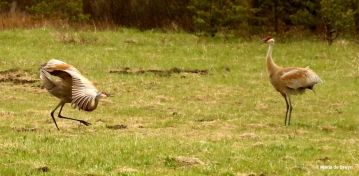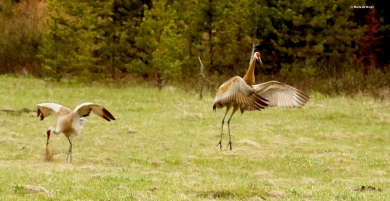Although we in the Northern hemisphere are already a little more than a month into summer, many species among our avian friends have not yet completed their breeding cycle. In my yard, many parents are still feeding begging (sometimes almost adult) children. Others are feeding young ones in the nest and some appear to be busy constructing new nests for a second or third brood. So, after a long hiatus in blogging, I decided to feature some of my bird friends, including the American goldfinch pair below (Spinus tristis) as they have worked on their new family lives in 2020.
 Some of these photos go back to early spring. A series of misfortunes (including a crash of my laptop hard drive, a broken camera, loss of Internet) meant that I had a backlog of photos to process and then suddenly a large gap in photos taken. But I managed to recuperate some of the work and hope you enjoy the coming series of posts about the birds’ breeding and family life!
Some of these photos go back to early spring. A series of misfortunes (including a crash of my laptop hard drive, a broken camera, loss of Internet) meant that I had a backlog of photos to process and then suddenly a large gap in photos taken. But I managed to recuperate some of the work and hope you enjoy the coming series of posts about the birds’ breeding and family life!
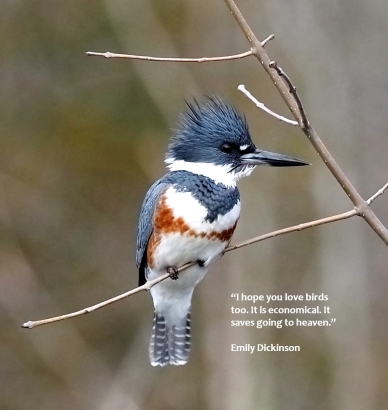
Breeding season is heralded by increasing bird song in the meadows, forests, fields and our yards. Males especially sing to attract mates and establish territories, but females treat us to songs and calls, too. This makes it easier to spot birds as the tree foliage gets thicker, especially if you have good hearing!


Pine warbler (Setophaga pinus) White-eyed vireo (Vireo griseus)


Eastern meadowlark (Sturnella magna) Orchard oriole (Icterus spurius)


Carolina wren (Thryothorus ludovicianus) Blue grosbeak (Passerina caerulea)

Summer tanager (Piranga rubra)

Indigo bunting (Passerina cyanea)
Courtship is usually a sweet behavior to watch in my view. The male Northern cardinals (Cardinalis cardinalis) are especially devoted suitors, seeking out nice morsels to present to their intended mates, while among the American crows (Corvus brachyrhynchos), it’s the females who loudly call to their mates for some tasty bites.

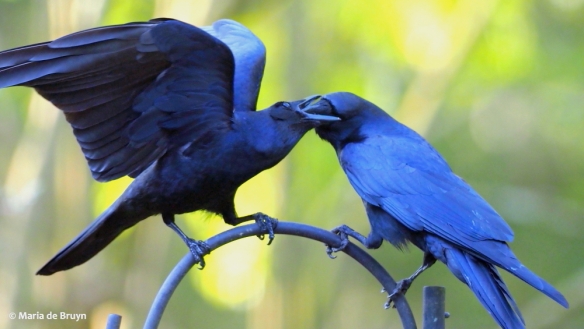
A fact that perhaps many bird lovers do not know is that few male birds have a penis. Like the female birds, most species’ males have a cloaca, a cavity externally located just under the bird’s tail and internally at the end of the digestive tract. Feces, urine, sperm and ova are all deposited in the cloaca. Birds who reproduce with this organ briefly rub their cloacae together (an activity called the “cloacal kiss”) whereby sperm from the male bird’s testes are transferred into the female’s cavity to unite with her eggs. During breeding season, the cloaca is slightly swollen and protrudes a bit from the bird’s body, facilitating the transfer. In the photo of this Carolina wren, you can see a slightly darker area under the tail indicating where the cloaca is found.


When ready for mating, the red-headed woodpeckers (Melanerpes erythrocephalus) seem to focus mainly on chasing away rivals and then snatching a quick mating session. The female woodpecker then takes a break from the chase to rest and have a bite to eat.
Some cliff swallow males (Petrochelidon pyrrhonota) seem to take advantage of females who are preoccupied with gathering mud for their nests for a quick tryst.

The brown-headed cowbirds (Molothrus ater) seem to take their time for mating. This pair was occupied for at least 5-10 minutes in preparing for the upcoming production of eggs. At times, it seemed like the male was giving the female instructions on what to do once “the deed” was done!


Many birders do not like the cowbirds because they are parasitic nesters, i.e., they lay an egg in another bird’s nest so that the other bird will raise the young. Since the cowbird baby usually hatches before the other eggs, they either monopolize the food that the foster parents bring or they may even destroy the eggs laid by their foster mother.


It’s been posited that the cowbirds evolved to use this strategy because they followed the bison in migration and therefore couldn’t stay in one place to raise their young. Others believe, however, that the birds developed the practice because dispersing their eggs over several nests gave their young a better chance of reaching adulthood.
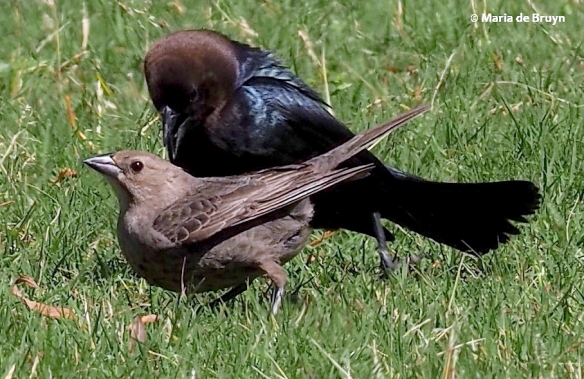
 The quickest mating scenario I’ve witnessed came from a pair of sweet little chipping sparrows (Spizella passerina). I’d seen the two fluttering together at the feeders and had noted one sparrow chasing another away – which I now think was the victorious suitor driving away a rival. Then one July afternoon, the two flew to a dying cedar and sat close to one another on a branch. Suddenly, Mr. Victory mounted his mate but for what only seemed a few seconds – really very quick work indeed! She sat there with her rear end elevated for a bit and then the two went back to feeding – and soon after I saw them collecting nesting materials.
The quickest mating scenario I’ve witnessed came from a pair of sweet little chipping sparrows (Spizella passerina). I’d seen the two fluttering together at the feeders and had noted one sparrow chasing another away – which I now think was the victorious suitor driving away a rival. Then one July afternoon, the two flew to a dying cedar and sat close to one another on a branch. Suddenly, Mr. Victory mounted his mate but for what only seemed a few seconds – really very quick work indeed! She sat there with her rear end elevated for a bit and then the two went back to feeding – and soon after I saw them collecting nesting materials.

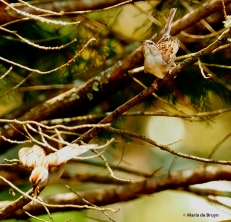
The birds in which the males do have a penis include some duck and swan species, ostriches, cassowaries, kiwi and geese. They differ from other birds in that development of the penis is NOT stopped in the male bird embryos during development (the case in cloacal birds).
The mallard males (Anas platyrhynchos), like some other ducks, unfortunately do not treat their partners well. They may mount the female very roughly. During a mating, she may be dunked underwater repeatedly and at length; occasionally, this results in her drowning. This behavior has been the subject of various studies and some newspaper articles with sensationalistic headlines (e.g., “The horrible thing you never knew about ducks)”.

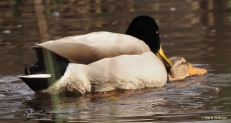

Once the actual mating is over, the birds devote most of their energy toward building a nest. While female ruby-throated hummingbirds (Archilochus colubris) must construct her nest and tend her babies alone, many other birds cooperate in the venture, like the Eastern bluebirds. Their efforts are featured in the next blog. (And if you’d like to see a previous post on courtship, it is here.)


 While one of our common birds, the gently cooing mourning doves (Zenaida macroura), are a little unusual in that they can mate at any time during the year, they mostly prefer to start their nesting period in the spring. And one pair in my yard were so kind as to allow me to watch them canoodling on a feeder pole this week. As many of these doves mate for life, perhaps they had lost any feelings of shyness. 🥰
While one of our common birds, the gently cooing mourning doves (Zenaida macroura), are a little unusual in that they can mate at any time during the year, they mostly prefer to start their nesting period in the spring. And one pair in my yard were so kind as to allow me to watch them canoodling on a feeder pole this week. As many of these doves mate for life, perhaps they had lost any feelings of shyness. 🥰
































 The quickest mating scenario I’ve witnessed came from a pair of sweet little chipping sparrows (Spizella passerina). I’d seen the two fluttering together at the feeders and had noted one sparrow chasing another away – which I now think was the victorious suitor driving away a rival. Then one July afternoon, the two flew to a dying cedar and sat close to one another on a branch. Suddenly, Mr. Victory mounted his mate but for what only seemed a few seconds – really very quick work indeed! She sat there with her rear end elevated for a bit and then the two went back to feeding – and soon after I saw them collecting nesting materials.
The quickest mating scenario I’ve witnessed came from a pair of sweet little chipping sparrows (Spizella passerina). I’d seen the two fluttering together at the feeders and had noted one sparrow chasing another away – which I now think was the victorious suitor driving away a rival. Then one July afternoon, the two flew to a dying cedar and sat close to one another on a branch. Suddenly, Mr. Victory mounted his mate but for what only seemed a few seconds – really very quick work indeed! She sat there with her rear end elevated for a bit and then the two went back to feeding – and soon after I saw them collecting nesting materials.



































